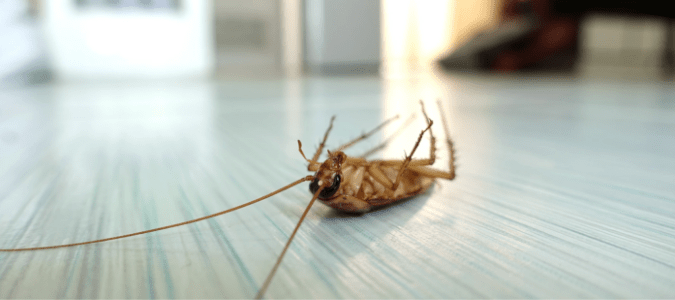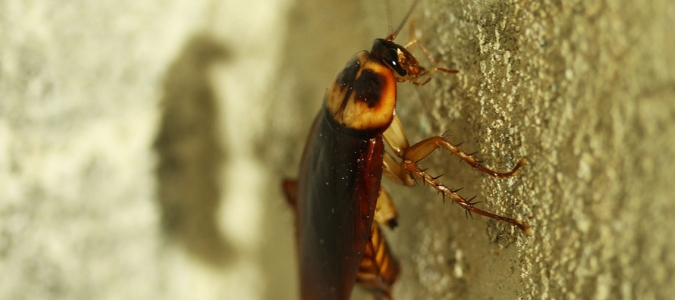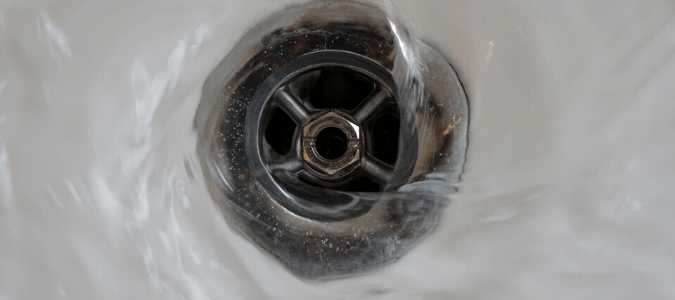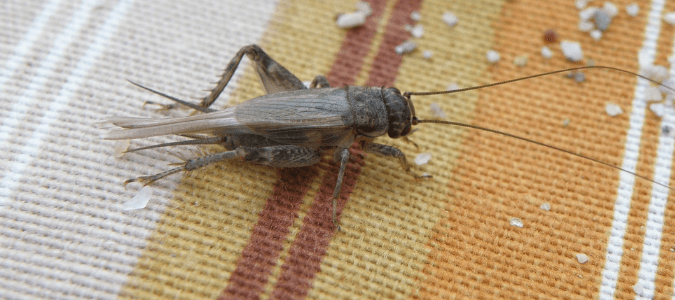
You turn on the bathroom light in the middle of the night and spot it—a cockroach. The next morning as you go into the kitchen, you spot another one, scuttling away. After a few of these unwelcome encounters, you’ve come to the conclusion that you have cockroaches in your home. Most importantly, you want that to change. When it comes to getting rid of roaches, often the best route is to contact a pest control specialist who can apply effective treatments to roach nesting and breeding grounds. However, there are some things you can do to help limit your roach population and make your home less attractive to these common pests.
The first step to eliminating a roach infestation is pinpointing where these creatures are nesting. Common areas around a home include:
- Around sinks in the bathroom and kitchen
- Behind the refrigerator
- In closets and cabinets
- Under beds or couches
- Around doors or windows
When you’ve discovered where these roaches are most concentrated, it’s time to get to work.
Eliminate Food Sources
Since the primary reason any pests invade our spaces is for nourishment, clean thoroughly. Seal food that is stored in pantries or cabinets in airtight containers, including pet food. Take your trash out regularly and put dirty dishes in the dishwasher promptly after a meal. Wipe down your counters, sweep, vacuum and do whatever you need to do to eliminate any potential food sources. When cockroaches come into contact with any type of organic matter, they will eat it. This includes not only food in your pantry, but also decaying wood, fingernail clippings and even dust.
By keeping your home spotless, you’ll also be able to clean up any traces of roach excrement, which is more prevalent when you have more pest activity. This is important, as roaches are capable of transmitting diseases through their feces, such as Salmonella.
Eliminate Water Sources
Simply taking away a cockroach’s food source isn’t enough. What many homeowners don’t know is that these insects are cold-blooded, so they can survive for months without food. If a roach gets desperate enough, it can even eat its own young. Cockroaches can only survive for a week without water, so be sure to fix dripping sinks or leaks in the garage. While you are at it, inspect areas of your home that are in close proximity to water, such as your kitchen, bathrooms and laundry room, for any areas of excess moisture or leaks. If you discover any issues, make needed repairs promptly.
Use Traps
By putting out roach baits and sticky traps, you can help to reduce the population of adult roaches on your property. Place these traps in areas where you’re seeing frequent roach activity or signs of roaches. Even after your problem has been handled by a pest control professional, you can leave traps in these areas to prevent future roach activity.
Unfortunately, as you are probably aware if this isn’t your first time dealing with roaches, you probably won’t see results overnight. It may take a few weeks, or even months, to get roaches out of your home. As you are testing out different methods of DIY roach control, these creatures are reproducing, filling your home with even more of their relatives, drawing out the timeline and making your job even harder. To make matters worse, female cockroaches can breed without the help of a male cockroach.
These pests have been around for millions of years and have evolved to become extremely resilient. According to the National Pest Management Association, roaches can even live for a whole week without their head! When it comes to roach control, taking shortcuts or even trying to use a single strategy may not be effective at keeping roaches away in the long term.
The more you know about these pests, the better equipped you will be to handle a problem. In this post, we will ask common homeowner questions about the dangers roaches pose, what methods are effective for eradicating these pests and how a person can identify whether the pest in their home actually is a cockroach.

Do Ultrasonic Pest Repellers Work On Roaches?
Ultrasonic pest repellers are devices that you can purchase which plug into an electrical outlet and emit high-frequency noises that are intended to injure, repel or eliminate common household pests, including insects and rodents. Unfortunately, these types of pest repellers don’t always live up to the claims on the box. According to the International Association of Certified Home Inspectors, studies of the effectiveness of these devices have had mixed results. One study by Kansas State researchers in 2002 found the devices had little impact on roaches. The majority of devices were found to be in violation of Federal Trade Commission guidelines, since they did not work as advertised.
The high-frequency sounds emitted by these products can cause pests to scurry around and run into traps, but they won’t eliminate them entirely. Also, depending on where ultrasonic repellers are plugged in, furniture and walls can block the sound from reaching the roaches.
In addition, there have been reports that ultrasonic pest repellers affect phone signals, security systems and hearing aids. On top of all of this, some pets are sensitive to the high-pitched noise that these repellers make and you could inadvertently end up making your dog, cat, rabbit or other pets distressed.
Another thing to keep in mind is that the longer pests live with the high-frequency noises, the more they will get accustomed to them. Which brings us to one last point: ultrasonic pest repellers are not a long-term solution.
Our advice? If you’re determined to use electronic pest repellers, make them just one piece of your pest elimination plan. Contact a pest professional to help with infestations, and keep traps around the house and keep your home clean and tidy to provide less of a reason for roaches to stick around.
We know that roaches can startle us when we are least expecting it, but you may be wondering if there are any other risks of having them on your property.

Are Cockroaches Dangerous?
Roach infestations are not enjoyable, and roaches themselves can be dangerous. While these pests don’t usually bite humans or pets, they can carry serious allergens and microbes that could cause harm to you and your family. If anyone in your family suffers from asthma, cockroaches are not creatures you want hanging around, as up to 60% of urban residents with asthma are sensitive to these allergens.
Even if you don’t have asthma, cockroaches are capable of spreading thirty-three different kinds of bacteria, including E. Coli and Salmonella, as well as six different parasitic worms and more than seven types of human pathogens. Roaches are also suspected carriers of organisms that can cause diarrhea, dysentery, cholera, leprosy and typhoid fever. Now you might think twice when you see one crawling across your kitchen counter. If you didn’t have a reason to get rid of roaches in your house before, you do now.
Remember, cockroaches breed incredibly quickly. Although they only live for one year, in that time, a female roach can produce up to 150 eggs. If you believe you have a cockroach infestation in your home, reach out to a pest control professional who start working on a strategy to keep your population in check.
One concern among homeowners is that even when roaches have been eliminated from a home, these pests might re-enter through drains and toilets, which brings us to our next question.

Can Cockroaches Swim?
Some cockroaches can “swim”, although it depends on how you define the term. Cockroaches technically float. They close their spiracles, or the holes on their body that they use to get oxygen, so that no water can enter their bodies. This prevents them from sinking. A roach can stay submerged in water like this for up to forty minutes. Therefore, drowning roaches isn’t necessarily an effective way to deal with these pests.
Many homeowners worry about this kind of behavior, because they are nervous that cockroaches will swim up drains, sinks and toilets. While this can happen, it is highly unlikely. Also, a cockroach infestation isn’t likely to start when one of these creatures floats up your pipes. Most roach problems are traced back to access points around doors, windows and entryways.
One more note about cockroach spiracles: Because these creatues breathe through these holes on their body, a cockroach can live without a head. As a result, a headless cockroach will eventually die of dehydration, not from suffocation.
While roaches are very common, there are a few other bugs that can be confused with these creatures.

Cockroach-Like Bugs
Are you sure it was a roach that just ran into that crack underneath your kitchen counter? Believe it or not, there are actually a number of bugs that people commonly mistake for cockroaches. If you aren’t completely sure you have roaches, you may want to consider a few other insect invaders:
- Crickets: Crickets are often the same size and color of cockroaches, as you can see from the picture above. However, these insects are mostly a nuisance. One of the most obvious signs of crickets in a home is noticing the sound of chirping. Unlike cockroaches, crickets can fly and jump.
- May Beetles/June Bugs: Depending on where you live in the country, you may call these insects May beetles or June bugs. These beetles are about the same size and same color as a cockroach, but they fly and are more likely to reside in your trees than in your home.
- Giant Water Bugs: These crawling bugs may look like a cockroach, but they prefer to be in close proximity to pools of standing water, whereas a roach prefers a humid environment. You can usually tell these two pests apart because water bugs have large pincers at the front of their bodies, while cockroaches do not.
Other ways to determine whether you have roaches or something else is by looking for these common signs of a roach infestation:
- Roach feces (typically small, brown or black cylinders)
- Roach skins, which may look like tiny roaches
- Roach eggs, which are yellow, cylindrical casings
- Brown smear marks throughout the home
- Live roaches
One of the best ways to identify what bugs are infesting your home is to set down glue traps and wait for pests to get stuck. While it’s not fun to examine these traps, examining what you find will help you take the right course of action. Pest control professionals can also help identify any pests that may be present.
ABC Can Handle Your Cockroach Infestation
When it comes to a pest as prolific and resilient as a cockroach, the best way to ensure your problem is gone for good is contacting a trusted pest professional. At ABC Home & Commercial Services, we put over 70 years of experience to use to create customized treatment plans for our customers to ensure we’ve eradicated the roaches on their property. In addition, we offer preventative service calls so you can feel comfortable knowing you won’t worry about another roach infestation.